Blog categories
Blog archive
RSS Blog posts tagged with 'interior design'
Blog Filters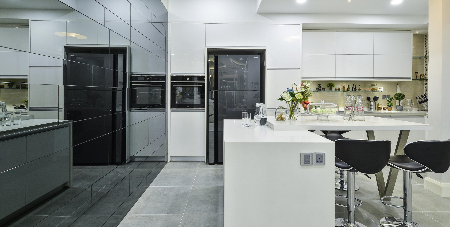
Sleek and Shiny: Pros and Cons of Using Reflective Kitchen Cabinets
Friday, November 20, 2020
Glossy cabinets in the kitchen are highly sought after, perhaps for the same reasons as lustrous minerals and polished baubles have been considered prized treasures since antiquity - a reflective surface imitates the world more accurately than any representational art form, while being nothing more than an otherwise meaningless object that has been polished smooth with effort, or a combination of time, pressure, and heat. If you happened across our analysis of materials commonly used in kitchen cabinets or countertops, and you have your heart set on updating your cooking space with glistening surfaces, you may be interested in taking a closer look at the advantages (and disadvantages) of reflective cabinets in the modern kitchen.
Smooth Surfaces
 Interior design by: Design Spirits
Interior design by: Design Spirits
While mirrored planes can be counted on to visually expand a space, most reflective surfaces are manufactured with a degree of smoothness that is measured in microns. This level of precision commonly entails an absence of texture in most materials, which can render a kitchen cold and aloof if large or seamless panes are applied without any discernible spacing to provide some semblance of texture. By applying reflective planes in a haphazard, brick-like configuration, the interior designer - Design Spirits provides this kitchen with both a visual expansion and a chaotic aesthetic element to contrast against the ordered lines of modern design.
Concealing Shade
 Interior design by: Hue Art Design
Interior design by: Hue Art Design
In addition to bearing little to no discernable texture, glossy cabinets will present greasy fingerprints more discernibly - in part, due to a characteristic imparting smooth planes with a “stickiness” (van der Waals forces), which attracts even the most microscopic of airborne particles and prominently displays light-disrupting dirt against a reflective surface. A slightly darker tint - as applied by Hue Art Design to the cabinets in this kitchen - will lessen the visual impact of dirt. Cleaning should be done periodically with a micro-fibre washcloth, to prevent scratches that could potentially add to the diffusion of light and result in slightly blurred reflections.
Intriguing Angles
Because mirrored surfaces reflect rather than absorb light, polished planes can be used to visually expand a space and provide unique perspectives that would not ordinarily be possible with matte surfaces. Designed by Zanotta, this kitchen utilises reflections to widen the scene and mystify the eye. Although partially obscured behind a projecting island, the polished doors on the lower cabinets present the entirety of the floor space to observers entering the kitchen - while the upper cabinets magnify the sunlight and warm yellow glows from the lighting fixtures.
Modern Circumstances
 Interior design by: Homlux Interior Furnishing
Interior design by: Homlux Interior Furnishing
The combination of space-expanding visual effects and typically narrow profiles make reflective planes one of the most indispensable ingredients of the modern urban home. Without the darkly-tinted reflected surfaces providing both visual expansion and contrast in this kitchen designed by Homlux Interior Furnishing, the narrow space may have otherwise appeared unbalanced with the abundance of stone, the extra height provided by the air-well, and the intense glow of the sun streaming in through the skylight.
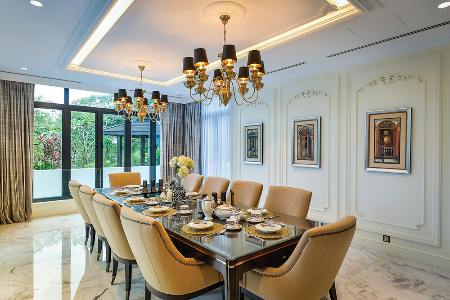
Trendy Touches: Top 2018 Interior Design Trends to Boost Your Home's Appeal
Friday, November 20, 2020
Here are the decorative styles and features you can expect in the coming year.
At the start of every year, we take a look back across the entire breadth of imagery we have collected over the last 12 months, to find the decorative features with the staying power to make it into the next year and onward. After considerable analysis and critiquing, we believe we have arrived at a guide for what to expect in 2018 - at least in the realm of interior design.
1 Classical Features We expect to see a continuation of classical features such as shaded chandeliers and plaster wall moulding adorning luxurious spaces in the coming year. While the world's burgeoning economies have been experimenting with regionally-relevant styles, neoclassicism of European influence has proven to be a dependable approach to fall back on - especially when overt opulence is the intended image.
 A number of discrete details have been incorporated into this dining space in order to bring the classic style to modern times: reflective trim around the dining table, metallic picture frames, and recessed area lighting hidden in the crevices of the ceiling. Designer: IDS Interior Design
A number of discrete details have been incorporated into this dining space in order to bring the classic style to modern times: reflective trim around the dining table, metallic picture frames, and recessed area lighting hidden in the crevices of the ceiling. Designer: IDS Interior Design
2 Dark Wood With natural materials such as wood and stone seeing greater use in our homes this past year, we expect to see a continuation of wooden decorative features and furnishings in dark shades to appeal to modern sensibilities - especially when paired with an immaculate expanse of white.
 This bar exudes luxury with dark wood laminate, white stone, and golden reflective accents serving as trim on the cabinetry. Designer: Metrics Global
This bar exudes luxury with dark wood laminate, white stone, and golden reflective accents serving as trim on the cabinetry. Designer: Metrics Global
3 Indoor Greenery Keeping in tune with our collective ambitions for ecological stability, another decorative feature gaining in rapid popularity is the humble indoor plant. Although previously spotted in vases or pots, really turning that dial labelled "Plants" all the way up and letting nature into your home does more than add some colour to the interior - you get higher quality air too.
 While the wall creepers in this case may not be living - on account of the wood floor presenting a practical problem in plant care, the mimicry serves to amplify the few green accents in this space. Designer: Nu Infinity
While the wall creepers in this case may not be living - on account of the wood floor presenting a practical problem in plant care, the mimicry serves to amplify the few green accents in this space. Designer: Nu Infinity
4 Industrial Influence With the large swathes of formerly industrial properties being converted into homes and centres of commerce around the world, we foresee a resurgence of post-industrial style represented by bare concrete and re-purposed wood or metal. Even in modern structures, we believe that materials that would have previously gone to waste are increasingly being given new life as decorative and functional features.
 Bare ceilings and a majority of concrete surfaces create a hard, sombre look that is cool yet fashionable. Designer: X-Two Concept
Bare ceilings and a majority of concrete surfaces create a hard, sombre look that is cool yet fashionable. Designer: X-Two Concept
5 Metallic Accents With the global consciousness finally sliding into a restorative mode at the tail end of 2017, we foresee a declining dependence on heavily processed materials such as gilded metals. Despite that potentially inflammatory forecast, metallic components will continue to surpass other materials such as wood in terms of the physical and aesthetic properties (such as damage resistance and translucence) that make them indispensable in particular furnishings and fixtures.
 Metal is used to keep the profiles of furnishings and light fixtures minimal, providing the interior with a greater sense of space. Designer: Humbert & Poyet
Metal is used to keep the profiles of furnishings and light fixtures minimal, providing the interior with a greater sense of space. Designer: Humbert & Poyet
Wondering what colours to expect in the coming year? Get it direct from some of the people who make your paint.
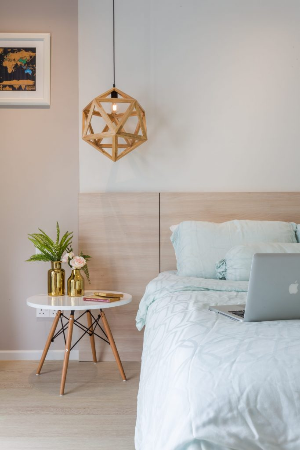
Designer Tips for Creating Beautiful Bedrooms
Friday, November 20, 2020
 Interior design by: Nu Infinity
Interior design by: Nu Infinity
Beauty may be subjective, but there are some factors we can all agree on. Get inspired by these designer ideas to create a cosy and eye-pleasing bedroom.
What is it about Leonardo da Vinci's Mona Lisa that makes it the iconic portrait that we know it as today? Some may point to her enigmatic smile, the detailed background, the possibility of it being a self-portrait, or even the array of time-worn details that add to its mystique. When art experts attempt to quantify the reasons that the Mona Lisa is so endearing and prevalent, we arrive at a set of factors that could not possibly have been known to even the original Renaissance man himself.
Even the grandmasters of the past could not have accurately predicted the outcome of every artistic endeavour, and yet the presentations that we appreciate as masterpieces today could not have been drafted without the necessary know-how and some form of forethought. To enable you to create your own masterpiece, we cut through the fog of various materials, styles, and other decorative options available, and summarized our top designer tips for creating truly striking bedrooms.
Open Layout
 Interior design by: Archicentre
Interior design by: Archicentre
Space being the luxury that it is in urban homes, bedrooms with en-suite bathrooms get a dose of extravagance from an open layout. Removing the walls between the bedroom and the en-suite bathroom makes the space larger - and paradoxically, more intimate. In tight quarters, opaque brick walls could be replaced with transparent or semi-transparent glass curtain walls to keep the bedroom dry. With adequate space, visual segregation could be achieved with bathroom fittings installed slightly higher to rest on a raised platform or with subtle transitions in architectural finishes.
 Interior design by: SNG Conceptwerke
Interior design by: SNG Conceptwerke
Natural Materials
 Interior design by: Design Base
Interior design by: Design Base
Ecological consciousness is apparently back in favour, resulting in a resurgence of natural materials dominating interior spaces. Even laminates mimicking stone or wood are useful for evoking a rustic or country ambiance - though for the sake of authenticity we highly recommend building up a thin façade of natural materials over existing walls.
Simple Geometry
 Interior design by: D' Concepto Design
Interior design by: D' Concepto Design
Where complex patterns and classical decorative elements may be overly imposing, consider less robust patterns or geometry in simple forms instead. Simple patterns and geometric shapes take up less visual weight, making small bedrooms seem larger, complementing modern and minimalist interiors.
Transparent Storage
 Interior design by: Homlux Interior Furnishing
Interior design by: Homlux Interior Furnishing
Instead of opting for opaque cabinetry with glossy or matte doors, which add weight to the space, showcase your clothing and maximise the spatial potential of your bedroom with transparent wardrobe doors. If your wardrobe choices result in haphazard bursts of colour, you can always tone down the effect of your collection by using slightly opaque wardrobe doors with a reflective sheen to reduce the visual impact of your garments’ colours.
Reflective Accents
 Interior design by: The Roof Studio
Interior design by: The Roof Studio
Aside from the widely understood fact that mirrors expand the perceived space, reflective materials such as mirrored glass or polished metal cut in simple lines or shapes serve to highlight transitions with a greater degree of elegance. When utilised in measured doses in conjunction with lighting fixtures, reflective accents cast an additional glow of redirected light to complement modern interiors.
 Interior design by: The Roof Studio
Interior design by: The Roof Studio
Dim Lighting
 Tip: Overly-wide expanses of plain walls can be broken up into proportions more suitable for the space with a lone strip of reflective material - conversely, smaller spaces can be given a visual expansion with a wide and uninterrupted plane of glass or metal. Interior design by: The Roof Studio
Tip: Overly-wide expanses of plain walls can be broken up into proportions more suitable for the space with a lone strip of reflective material - conversely, smaller spaces can be given a visual expansion with a wide and uninterrupted plane of glass or metal. Interior design by: The Roof Studio
For some, lighting of the warm white variety does more for a cosy atmosphere than cool white. While the latter is appropriate for a clean and breezy interior, the soft yellow glow of the former is reminiscent of candlelight or natural light at dusk and dawn - and is consequently more conducive for relaxation. Mix fixtures with cool white and warm white bulbs together for a little extra glitter and glam, or go completely warm white for a softly lit den.
Plush Fabrics
 Select materials based in neutral shades and adorned with simplistic motifs to reduce the visual weight of carpeting and drapery in the bedroom - or allow some creativity to be expressed with interesting patterns in the foreground. Interior design by: Nu Infinity
Select materials based in neutral shades and adorned with simplistic motifs to reduce the visual weight of carpeting and drapery in the bedroom - or allow some creativity to be expressed with interesting patterns in the foreground. Interior design by: Nu Infinity
There are few sensations as comforting as bare toes buried in deep fabrics. Incorporate thick drapery and deep-pile carpeting into a bedroom of any size to increase the depth of your furnishings and to make for a cosier space. To add more depth and push the comfort factor all the way to the top, alternate between layers of silky and fluffy textures with fabrics composed of differing materials and thread counts.
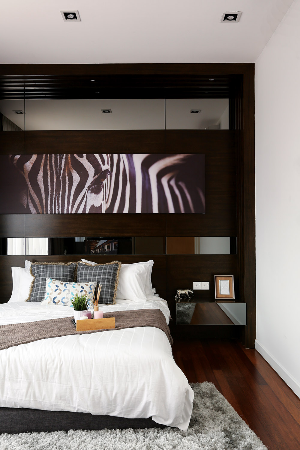
Charming Chambers: 5 Cosy Bedrooms with a Romantic Ambience
Friday, November 20, 2020
Decorating with your amore in mind? We combed through bedrooms throughout the country - and abroad, to rank the five coziest bedsteads for eliciting feelings of romance. Before the evening's events draw to a close and things inevitably lead back to the bedroom, be sure to have these decorative features in place to help your amorous ambitions along.
5. Monochromatic SimplicityMaking the most out of a few select trappings in their signature brand of monochromatic minimalism, Nu Infinity's arrangement speaks of wild passions: reflective panels frame a print of a zebra's patterns - strategically situated on the walls above the bed; a deep pile carpet in grey provides a comforting layer for bare feet to linger on; and a diminutive clutter tray adorned with the tools of aromatherapy provides the clearest signal of romantic intentions.
 Designer: Nu Infinity
4. Classically Feminine
Designer: Nu Infinity
4. Classically Feminine
Crisp, classically appointed architectural finishes and furnishings saturated in pale shades lend this bedroom a delicate and decidedly feminine elegance. The combination of daylight, or soft yellow lighting at night, help to bring out the tones of peaches and cream provided by the decorative wall treatments and fabrics. Amorous intentions are made clearer with the placement of a circular tub in view of the bed.
 Designer: S/Lab 10
3. Thoughtful Transition
Designer: S/Lab 10
3. Thoughtful Transition
The classical furnishings, intricate patterns in wallpaper, and exquisite lighting fixtures are the key elements in this bedroom helping to create an amorous vibe. A functional feature of special note is the thoughtful arrangement of seating around a coffee table equipped with refreshments to create an intimate space for romantic interludes.
 Designer: Hue Art Design
2. Exotic Excursion
Designer: Hue Art Design
2. Exotic Excursion
Conceived by interior designer, Nikki B, and situated within a gated community in Dubai, this bedroom exudes an exotic allure without resorting to the archetypal shades of romance. This intimate bedchamber in the desert presents decorative stone accents and elaborate fabrics in alternating swathes of blue and gold - the regional palette associated with luxury.
 Designer: Da Fonesca Design
1. Glamorous Detail
Designer: Da Fonesca Design
1. Glamorous Detail
This bedroom hits all the checkpoints in our list of things that make a bedroom exude romance: warm wood flooring contrasting against reflective accents on the walls, a circular bedstead displaying classical tendencies in the button-back upholstery, and just the right amount of shimmer in the materials.
 Designer: Gusto Design
Designer: Gusto Design
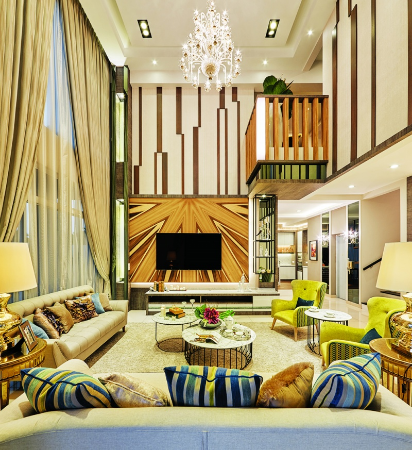
Luminous Elevations: How to Choose Lighting for Double-Height Living Rooms
Friday, November 20, 2020
The volume of air that comes with double-height ceilings typically calls for the use of impressive lighting fixtures that do more than just provide illumination - they inevitably become one of the focal points of attraction in living spaces. We combed through some delectable mansions, bungalows, duplexes, and penthouses to put this guide together and help you pick out the ideal chandelier (or other lighting fixture) to suit the extra-high ceiling of your décor.
Classical Chandeliers Equally appropriate in classical interiors as for lending an eccentric streak to modern settings, the many variations of glass or crystalline, and shaded or bare chandeliers are a requisite feature for anyone wanting a dependable style choice that can add a layer of elegance to a wide range of interiors.
 A classically inspired chandelier is a safe option to lend an aura of elegance to transitional or eclectic décors. Designer: The Roof
A classically inspired chandelier is a safe option to lend an aura of elegance to transitional or eclectic décors. Designer: The Roof
Curved Chandeliers A more common type of modern chandelier spotted in transitional and minimalist settings, the curved surfaces make for lower profile fixtures that do not intrude into the airspace. By virtue of their curved profiles and small size, many identical pieces can be hung together in staggered lines to depict heavenly bodies.
 Occupying less space than a conventional chandelier, the relatively small size of these metallic orbs enables the arrangement of multiple pieces in an array. Designer: Turn Design Interior
Occupying less space than a conventional chandelier, the relatively small size of these metallic orbs enables the arrangement of multiple pieces in an array. Designer: Turn Design Interior
Large-Scale Floor Lamps Take advantage of the abundance in ceiling space by incorporating an extra tall, floor-mounted lighting fixture. An imposing floor lamp represents an alternative focal point on an unanticipated plane and helps to preserve the volume of air provided by the high ceiling.
 The abundance of airspace in double-height spaces invites the use of over-sized floor mounted lighting fixtures. Designer: Turn Design Interior
The abundance of airspace in double-height spaces invites the use of over-sized floor mounted lighting fixtures. Designer: Turn Design Interior
Wall-Mounted Lights Maximize the conservation of airspace in your living room with low-profile lights mounted to walls. This arrangement can be used to highlight decorative walls higher up in the void while providing adequate task lighting and without hampering the intimate mood.
 Instead of an intrusive lighting fixture hanging in mid-air, this space presents discrete wall-mounted lights to produce an intimate atmosphere. Designer: IDS Interior
Instead of an intrusive lighting fixture hanging in mid-air, this space presents discrete wall-mounted lights to produce an intimate atmosphere. Designer: IDS Interior
Slim Spotlights If the dim illumination provided by wall-mounted lights is inadequate, or if you just want to highlight decorative furnishings nearer to the floor, consider using simple down-lights to obscure ceiling features in favour of highlighting furnishings on the ground.
 Pursuing a recording studio motif, this living room features utilitarian and low-profile down-lights to retain the sense of volume in this space. Designer: Motto Designs
Pursuing a recording studio motif, this living room features utilitarian and low-profile down-lights to retain the sense of volume in this space. Designer: Motto Designs
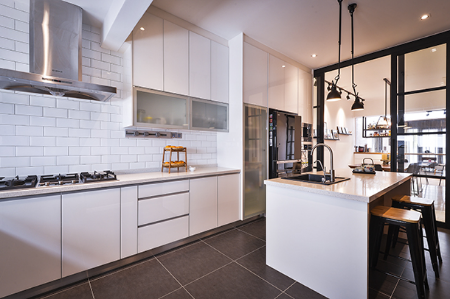
Galley Hues: Top 5 Colours for Your Kitchen
Friday, November 20, 2020
While white is a commonly used colour in kitchen spaces to maintain a clean atmosphere, some may want a little bit of a divergence with other colours from a neutral pallette to suit the rest of their home, or get a little bit creative with other colours to add some vibrance to their décor. Here, we take a look at the Top 5 colours for your kitchen.
 Designer: Yong Studio
Designer: Yong Studio
White Likely the most common pallete used for kitchens, the absence of colour contributes towards an immaculate atmosphere in kitchens with either modern or traditional stylings. The uniformity of white - stretching from ceilings, walls, backsplashes, countertops, cabinetry, and down to flooring makes these typically small areas of the home seem more spacious.
 Designer: Pocket Square
Designer: Pocket Square
Grey
The popularity of a using grey in kitchens emerged with the rise of the modern palette and granite countertops. The colour grey is most effective in a kitchen appointed with steel fixtures and reflective accents. Designer: GDY Design & Construction
Designer: GDY Design & Construction
Black Although typically confined to decorative accents, a kitchen is transformed into an inviting and elegant space when black is used as the base colour.
 Designer: Nu Infinity
Designer: Nu Infinity
Brown The natural shades of wood are ideal for both modern and country-styled kitchens, with darker shades creating a majestic effect and pale tones exuding a rustic flavour.
 Designer: Nu Infinity
Designer: Nu Infinity
Blue While pastel shades are associated with rustic interiors, modern kitchens can also benefit from the bespoke factor provided by saturation in a surprising hue of blue.
 Designer: Viincology
Designer: Viincology
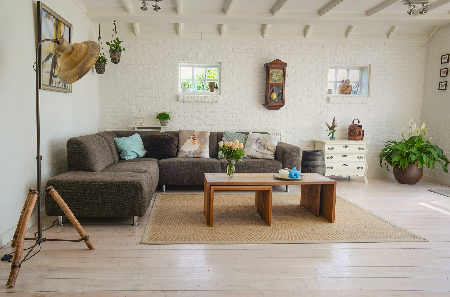
Zen Den: 8 Tips for Cultivating a Calm Atmosphere at Home
Friday, November 20, 2020
We spend many hours in our home. It’s where the day is started and sealed. It should be a place that fosters relief after the many to-dos and ventures of a day. Make the most of time at home by cultivating a relaxing, calm living space for yourself, your family, and your friends and guests. Whether in the living room, family room, bedroom, or other space, there are many small steps you can take to promote peace in the home. Follow these eight tips to transform home into a place you want to spend time in and relax in: 1. Give Everything a “Home” Having clutter on table tops, floors, and elsewhere can translate to feeling cluttered throughout your life. Make sure that your important things, like those needed on a daily basis (keys, for example), have a space that is easily accessible but not immediately visible. This will alleviate the sense of visual clutter. Keep doorways clear and items off and out of the spaces used for sitting and relaxing!
2. Set Atmosphere With Music
Having clutter on table tops, floors, and elsewhere can translate to feeling cluttered throughout your life. Make sure that your important things, like those needed on a daily basis (keys, for example), have a space that is easily accessible but not immediately visible. This will alleviate the sense of visual clutter. Keep doorways clear and items off and out of the spaces used for sitting and relaxing!
2. Set Atmosphere With Music
 Consider purchasing a portable speaker to connect to your phone, or set up a music streaming service on your TV for playing background music. Choose calming songs like instrumental soundtracks and classical pieces. Keep the sound low so you can hear the music but not too loud that people have to talk over the music.
3. Bring the Outdoors In
Consider purchasing a portable speaker to connect to your phone, or set up a music streaming service on your TV for playing background music. Choose calming songs like instrumental soundtracks and classical pieces. Keep the sound low so you can hear the music but not too loud that people have to talk over the music.
3. Bring the Outdoors In
 Bring vases of flowers or small plants inside. These provide color and calm. Choosing planters with decorative accents can improve the energy of a space as well. Live plants will clean the air and will not gather dust. The smell and life of indoor plants connects us with the outdoors, satisfying a fundamental human need for interaction with nature.
4. Let Light Shine
Bring vases of flowers or small plants inside. These provide color and calm. Choosing planters with decorative accents can improve the energy of a space as well. Live plants will clean the air and will not gather dust. The smell and life of indoor plants connects us with the outdoors, satisfying a fundamental human need for interaction with nature.
4. Let Light Shine
 Open windows, blinds, and drapes to permit sunlight to come in. Natural light will brighten the space, will help regulate hormones during the day, and will make the space feel bigger and cleaner, which has an instantly calming effect. Exposure to natural light is important for maintaining circadian rhythm, so allowing it into the home has health benefits. Reflective surfaces, such as mirrors and clean spaces, can make your space even brighter and feel bigger.
5. Freshen Up
Open windows, blinds, and drapes to permit sunlight to come in. Natural light will brighten the space, will help regulate hormones during the day, and will make the space feel bigger and cleaner, which has an instantly calming effect. Exposure to natural light is important for maintaining circadian rhythm, so allowing it into the home has health benefits. Reflective surfaces, such as mirrors and clean spaces, can make your space even brighter and feel bigger.
5. Freshen Up
 Consider opening windows to bring in natural air. Plug in light air fresheners or burn a scented candle to plant fresh smells inside. Essential oils, aromatherapy, or room sprays may also help temper the atmosphere. Use smells that have a calming or cleaning effect, such as lavender or lemon. Dusting down surfaces will help maintain a neat appearance.
6. Paint With Light or Neutral Colors
Consider opening windows to bring in natural air. Plug in light air fresheners or burn a scented candle to plant fresh smells inside. Essential oils, aromatherapy, or room sprays may also help temper the atmosphere. Use smells that have a calming or cleaning effect, such as lavender or lemon. Dusting down surfaces will help maintain a neat appearance.
6. Paint With Light or Neutral Colors
 Avoid bright statement walls or overly energizing colors like bright red and blue. Don't clutter walls with tons of pictures, photos, or frames. Instead, paint the walls with muted colors, neutral colors, or your favorite relaxing blend of colors. Leave the bright colors to accent pieces or items for display. Consider one or two larger focal pictures or an interesting piece of art to draw attention to a few central points in the room to avoid overstimulation.
7. Prepare for All Temperatures
Avoid bright statement walls or overly energizing colors like bright red and blue. Don't clutter walls with tons of pictures, photos, or frames. Instead, paint the walls with muted colors, neutral colors, or your favorite relaxing blend of colors. Leave the bright colors to accent pieces or items for display. Consider one or two larger focal pictures or an interesting piece of art to draw attention to a few central points in the room to avoid overstimulation.
7. Prepare for All Temperatures
 Have pillows and blankets available for snuggling up on your favorite couch or chair. Have a couple blankets for warmth and ensure that they have different thicknesses and textures so you have "just right" warmth no matter the weather or room temperature. Blanket and pillows are also great for providing texture in the home and can add a sense of calming aesthetic interest wherever they are displayed.
8. Keep Your Favorite Things in View
Have pillows and blankets available for snuggling up on your favorite couch or chair. Have a couple blankets for warmth and ensure that they have different thicknesses and textures so you have "just right" warmth no matter the weather or room temperature. Blanket and pillows are also great for providing texture in the home and can add a sense of calming aesthetic interest wherever they are displayed.
8. Keep Your Favorite Things in View
 While it is typically good to avoid overcrowding a space, having your favorite books, magazines, or photos out of the things you love and favorite memories can add positivity and comfort to the room. Keep out only those keepsakes that have special value to you. Use these to keep you calm during your relaxing time, refresh your memories, or motivate you for your next adventure.
Consider these steps as you clean and renovate your home. Keeping your space calm and reflective of your values and personality will transform your home into a place of restoration and peace, which is the best possible effect it could have!
Article courtesy of Olivia Warfield, a contributing writer and media relations specialist for Atlas Heating & Air Service. She writes for a variety of DIY and lifestyle blogs.
While it is typically good to avoid overcrowding a space, having your favorite books, magazines, or photos out of the things you love and favorite memories can add positivity and comfort to the room. Keep out only those keepsakes that have special value to you. Use these to keep you calm during your relaxing time, refresh your memories, or motivate you for your next adventure.
Consider these steps as you clean and renovate your home. Keeping your space calm and reflective of your values and personality will transform your home into a place of restoration and peace, which is the best possible effect it could have!
Article courtesy of Olivia Warfield, a contributing writer and media relations specialist for Atlas Heating & Air Service. She writes for a variety of DIY and lifestyle blogs.

Silent Nights, Pretty Lights: Lighting Ideas for a Bright and Festive Ambience at Home
Friday, November 20, 2020
Enhance the Christmas mood at home with these beautiful lighting ideas that add a spark of joy in every corner.
Create a focal point at your dining table by using an attractive pendant light accompanied by festive centrepieces beneath it. Choose a colour theme - for instance gold to bring on a touch of elegance. (Image credit: Luxxu)

Minimalist-looking lighting works well when paired with festive decoration. (Image credit: Boca do Lobo)

Whether you pop one up in your porch, on feature walls or at entryways, mounted wall lights with a festive theme easily infuse homes with a Christmas ambience. (Image credit: Lights4fun)

Decorate a corner with Xmas features. To enhance the look, hang fairy lights across the wall and brighten the space up with candlelight. (Image credit: Lights4fun)
More Christmas decorating tips here.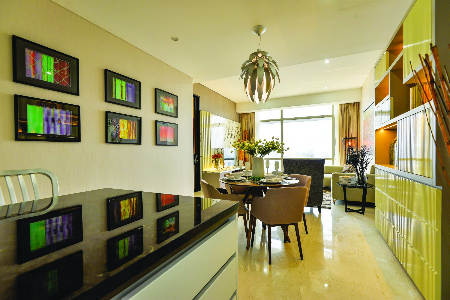
10 Ideas for Combining Your Dining and Living Spaces
Friday, November 20, 2020
Beyond just arranging dining and living room furniture sets near each other, there are a host of other considerations that one should look into when combining these two functionally separate areas.
 Interior design by: Kuzoj
Interior design by: Kuzoj
With space at a premium in urban homes, combining two of the areas that often take up the most space is a practical way of freeing up room for other functions. But things can get a little busy and cluttered when combining dining and living areas in small spaces such as a studio apartment or a home with an open floor plan. In light of the many ways that this merging can be achieved, we took a look at the most notable combined spaces we have seen over the years and extracted the base ingredients for your perusal here.
1. Grouped Arrangements
If you have the space to spare in your open plan home, the easiest way to combine the dining room with seating lounge is to position the respective furniture into two separate but adjacent groups - with an empty gap for a walkway between the two groups providing a means of access and to act as subtle demarcation.
 Interior design by: SQFT Space Design Management
Interior design by: SQFT Space Design Management
2. Narrow Spaces
For a comfortable dining experience, diners need between 90cm to 1.3m of space to be able to pull out a chair and take a seat, with around 60cm to 70cm of space between each seat for adequate elbow room. If space is limited, opt for a narrow rectangular table to discretely occupy the space on one side of the seating lounge.
 Interior design by: Pocket Square
Interior design by: Pocket Square
3. Informal Seating
At the most extreme end of the scale, one could also go beyond merging dining and living areas, by having seating and dining table occupy the same space. Replacing chairs on one side of a dining table with an upholstered bench creates a casual setting for meals and enables one to forgo having a sofa set - if the comfort and formality are not to be missed.
 Interior design by: The Roof
Interior design by: The Roof
4. Wall Features
To rein in the surplus empty space in your open plan layout, build up false wall projections and turn them into shelving or see-through niches to provide a means of visual separation as well as a functional fixture for additional storage.
 Interior design by: Beata Home and Office Furnishing
Interior design by: Beata Home and Office Furnishing
5. Decorative Ceilings
Even the thinnest of wall façades will take up some space, if only a negligible amount. To clearly demarcate your combined dining and seating lounge without occupying any of the valuable floor space, consider forming borders on the ceilings to visually indicate the extents of the functionally separate areas.
 Interior design by: Design Base
Interior design by: Design Base
6. Island Bars
Even without a dry kitchen adjacent to the seating lounge, it is possible to incorporate bar-height counters or kitchen islands - along with some stools or chairs of appropriate height, to provide a dining space in close proximity. Opting for countertop dining makes for a casual dining experience, and frees up additional space for other uses, such as a more spacious seating lounge.
 Interior design by: Pins Studio
Interior design by: Pins Studio
 Interior design by: Luna Solutions
Interior design by: Luna Solutions
7. Raised Platforms
With a small measure of additional space in an open floor plan, a slightly raised wooden platform would serve to elevate, highlight, and to keep the dining space visually distinct from any nearby seating.
 Interior design by: Pins Studio
Interior design by: Pins Studio
8. Decorative Archways
Building up a decorative archway between dining and seating furniture is another space-efficient way of define the combined areas, but best results are achieved in wide spaces so as not to make the open floor plan appear cramped.
 Interior design by: D'Concepto Design
Interior design by: D'Concepto Design
9. Dividing Drapery
In lieu of features such as arches, shelving, or see-through niches, an opaque or transparent curtain can be drawn shut to provide a temporary privacy screen during meals, and opened between meals to preserve the spaciousness of the open layout.
 Interior design by: Zids Design
Interior design by: Zids Design
10. Unifying Style
Whatever the means you have chosen to apply in visually indicating the separate functions of your combined dining and seating area, a harmoniously applied decorative style will serve to unify the distinct spaces. A unifying style does not necessarily entail a repeated palette, as a cohesive décor can still be achieved with complementary colour pairs applied as interchangeable base and accent colours.
 Interior design by: Nu Infinity
Interior design by: Nu Infinity

Christmas Centrepiece: How To Create a Festive Centrepiece for Your Dining Table
Friday, November 20, 2020
If you find yourself wondering how to make your spaces more festive this Christmas, consider using centrepieces to enliven your dining table. Here are a few simple ways to whip up a good-looking decor piece for your tables.
Fabrics A decorative tapestry such as oriental table runners or a simple cloth serves to underscore centrepiece arrangements with a layer of texture and to protect dining surfaces from scratches. Anything as overt as plain fabrics dyed in red or green to tartan and plaid textiles in subtle colours will evoke the Christmas spirit in varying degrees.
 Image Source
Image Source
Thematic Decorations As with fabrics, decorative objects can be as obvious as cut branches of red European holly (Ilex aquifolium), snowflakes in crystal, and figurines depicting the requisite characters of the season - or as understated as pine cones and a variety of edible berries.
 Image Source
Image Source
Silverware Associated with prosperous clan gatherings during the holiday season, the reflective sheen of silverware conjures impressions of snow-covered landscapes. As food will inevitably be found scattered over dining surfaces - often before the whole family even sits down for dinner, consider integrating silver-gilded containers of edibles or beverages into centrepiece arrangements.
 Image Source
Image Source
Glassware Glassware and other crystalline decorations can be used as an alternative to silver containers to add some shine to centrepieces. Glassware such as snack bowls and beverage pitchers, or thematic crystalline decorative objects are best appreciated in direct light to add a measure of intricate elegance to the centrepiece.

Lighting Candles and accent lighting can applied adequate lighting for diners as well as be part of your centrepiece arrangements while maintaining an intimate mood. Turn up narrow downlights directly over centrepieces to heighten metallic and crystalline decorations and improve task lighting with a scattering of tea candles or paraffin lamps.
 More Xmas decor tips for every room in the house here. For timeless centrepiece decor for dining tables, check out this article.
More Xmas decor tips for every room in the house here. For timeless centrepiece decor for dining tables, check out this article.





